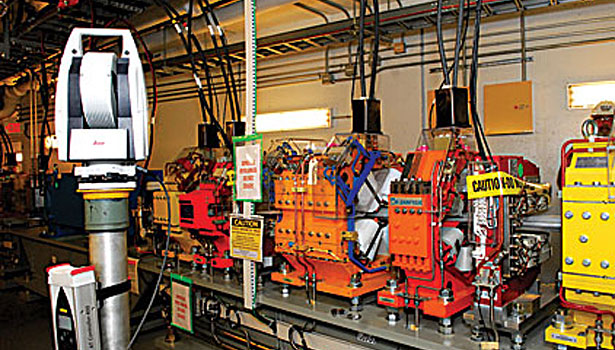An aerial view of Brookhaven National Laboratory (BNL) in Long Island, NY, shows an impressive half-mile ring structure: the National Synchrotron Light Source II (NSLS-II) accelerator, scheduled for completion in 2015. NSLS-II will support research in engineering, biology, physics, chemical and materials sciences, and nanoscience.
This new facility replaces the original National Synchrotron Light Source accelerator, which opened in 1982. It generated infrared, ultraviolet and X-ray light that enabled scientists to probe fine particles, materials and processes.
In contrast, the NSLS-II will use advanced instruments, optics, and detectors to produce X-rays more than 10,000 times brighter than the original light source. NSLS-II consists of a linear accelerator, a booster ring and an energy storage ring, which is 792 meters long and will produce 3 billion electron-volts when operational.
Recently, BNL’s engineers completed the first phase of storage-ring construction after three years. It involved delivery and initial alignment of the 150 girders (holding 843 magnets) needed to focus a near-light-speed electron beam through the ring.
Phase two involves finalizing tolerance alignment of the girders from 100 microns to 30 microns. To ensure accuracy and quicken project completion, the 12-member survey and alignment group uses nine Leica AT401 laser trackers made by Hexagon Metrology Inc.
Portable and lightweight (about 30 pounds), the AT401 has a small footprint and is powered by an internal battery. With the click of a button, predefined measurement modes adjust the tracker to different environmental conditions, while maintaining precision in a large work envelope.
“Laser tracking saves many hours of work [because it] captures horizontal and vertical measurements simultaneously,” says Chenghao Yu, photon sciences directorate for the National Synchrotron Light Source II. “Its noncontact measurement capability is used to evaluate very precise concave and convex mirrors, relate them to outside fiducials, and verify their shape when bent or twisted.”
The survey and alignment group especially likes the tracker’s PowerLock feature that uses vision technology to detect a reflector and automatically lock the laser beam onto it, even when a target is moving. This helps them work around cabling and other obstructions that disrupt the line of sight from target to tracker.
Spatial Analyzer metrology software (also made by Hexagon Metrology) enables the trackers to gather and record 3D data. All measured and processed data files are stored on a SharePoint site for use later in the process. The group’s survey engineers have written many measurement plans with the software.
For more information on laser trackers and metrology software, call 855-433-9638 or visit www.hexagonmetrology.us.
